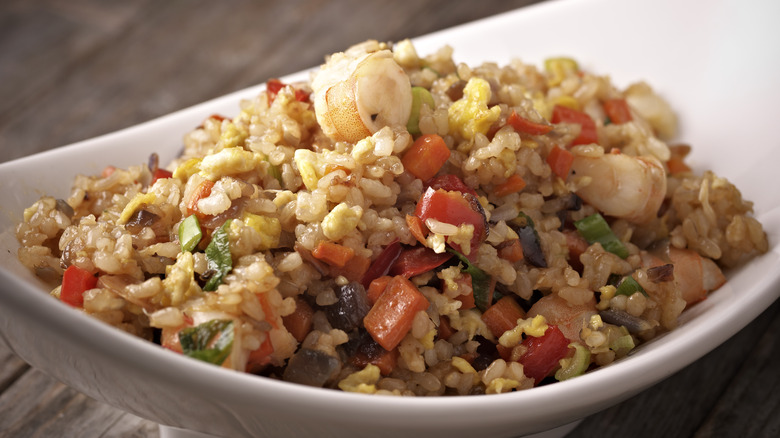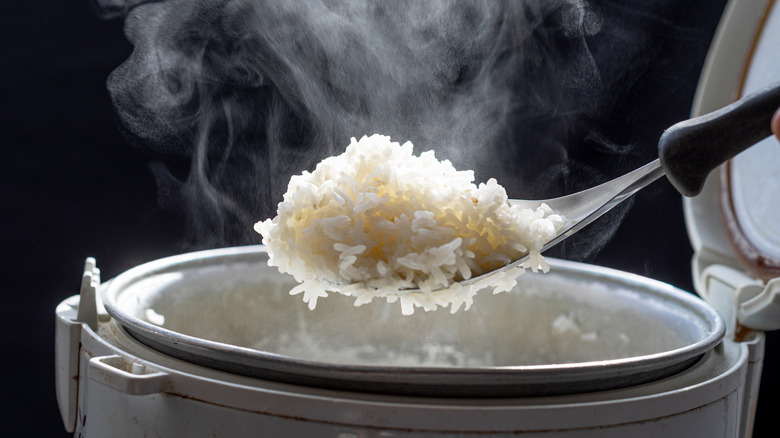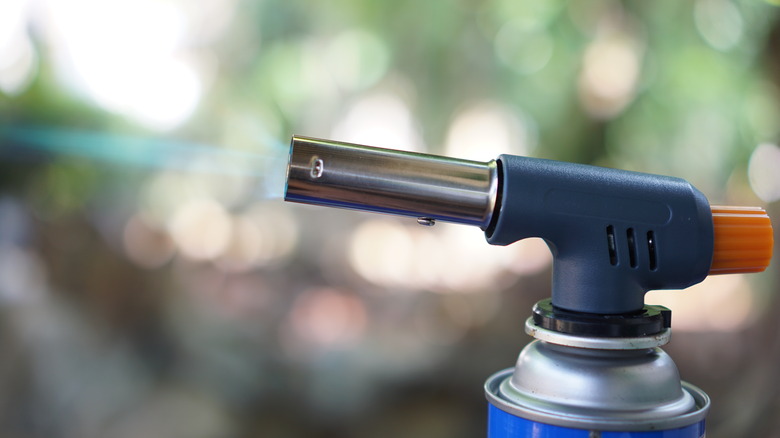You Definitely Don't Need A Wok For Takeout-Style Fried Rice
Many people believe that a wok is necessary for making authentic fried rice. To be honest, there's some truth in that. It's hard to deny that something quite magical happens when cooking with a wok, wok stove, and powerful gas burner. The wok setup creates flame-infused, high-heat flavors, which are what makes wok-cooking so unique, along with how rapidly the ingredients are cooked. This combination of using speed and flame to create flavor is called wok hei, or "breath of the wok." Without a great deal of skill or the right setup, as the reporter in this video segment from South China Morning Post admits, "It's pretty clear that it's very hard to achieve proper wok hei at home."
But don't despair! Just because it's not easy to create wok hei without a wok, you can still make outstanding takeout-style fried rice at home. The secret to this lies in understanding two things: The tricks that really make takeout-style fried rice delicious, and knowing how to adapt your approach to suit whatever combination of stovetop and pan you have.
At its core, takeout-style fried rice consists of only a handful of readily available ingredients (rice, egg, oil, soy sauce, scallions). Plus, it only takes a couple of minutes to cook, which is probably less time than it'd take your local takeout to deliver it to you. So, let's delve into the secrets of making takeout-style fried rice at home.
Tricks to make takeout-level fried rice at home
Wok or no wok, fried rice is a dish best cooked quickly, on a high heat. Make sure all your ingredients are ready before you begin: Your eggs are beaten, the caps removed from your oil and soy sauce, the scallions have been chopped, and the rice is cooked, cooled, and dry. The received wisdom is that it's best to make fried rice using leftover cooked rice. There are also some secret ingredients to consider: Shaoxing wine or mirin, its sweeter Japanese counterpart, can be used to deglaze, while sesame oil adds a smoky flavor to compensate for the missing wok hei.
Before you start cooking, preheat your pan until it's literally smoking hot: Fried rice — as with cooking the best skirt steak – needs intense heat. Once the pan's smoking, add in a high smoke point oil to coat the pan. You should add oil at various points throughout the recipe — see it as a way to protect all other ingredients from sticking to the super-hot pan immediately. Finally, when you add your beaten eggs to the hot oil, don't scramble them. Leaving them to form a sort of omelet before adding rice will yield a fluffier egg, which will take on color in the pan better.
The way without the wok
Because stovetops are much less powerful than woks, you'll want to keep the heat at maximum throughout the fried rice-making process when you're cooking at home. When cooking on a gas stovetop, if you don't have a wok available, that's fine. In fact, because of the concave shape of a wok and the lower heat generated by the gas stove compared to a high-power wok burner, you're probably better off using a flat bottom pan anyway. When it comes to cooking with electric or induction, a flat bottom non-stick pan becomes essential: Contact is required to generate heat in the pan, and the concave wok's reduced contact area just won't cut it.
There are, of course, some things only a wok can achieve. Your rice will be ready in minutes rather than the seconds it takes some experienced wok masters. Incidentally, you'll know your fried rice is ready when the rice starts to spit and jump when you're not moving the pan. You'll not be able to achieve that elusive and oh-so-desirable wok hei, although you can try to recreate this effect at home by blowtorching your rice.
Ultimately, if you use all the tips outlined in this article, your homemade fried rice should be as good as takeout. And if all this fast-paced stovetop action sounds a little too intense, there's one fried rice hack that removes your stove from the equation entirely.


